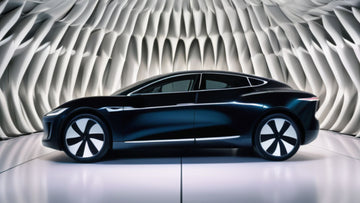Key Highlights
- The global automotive acoustic material market is projected to reach $6.6 billion by 2031, growing at a CAGR of 6.4% from 2022 to 2031.
- The rise in demand for enhanced comfort and safety features in vehicles is fueling the growth of the automotive acoustic material market.
- Luxury vehicles are experiencing increasing demand, leading to the adoption of advanced acoustic materials to improve the riding experience for passengers.
- Asia-Pacific is the largest regional market for automotive acoustic materials, followed by Europe and North America.
- Stringent government regulations for economic assistance and vehicle noise drive the market for automotive acoustic materials.
- The use of sustainable materials and advances in sound absorption and insulation technologies are shaping the future of the auto acoustics market.
Introduction
The global automotive acoustic material market is experiencing significant growth and is projected to reach $6.6 billion by 2031, with a CAGR1 of 6.4% from 2022 to 2031. Automotive acoustic materials reduce vehicle noise and vibration, providing passengers with a comfortable and safe riding experience. These materials include foams, fabrics, and metals that can absorb and dampen sound waves, reducing noise pollution inside and outside vehicles.
In recent years, there has been a growing demand for enhanced comfort and safety features in vehicles. Consumers are increasingly seeking premium cars that offer high comfort and a quiet cabin environment. As a result, automakers focus on incorporating advanced acoustic materials in their vehicle designs to improve the overall riding experience. Luxury vehicles, in particular, are equipped with advanced acoustic materials to reduce noise and vibration and provide a luxurious and comfortable interior environment.
The Asia-Pacific region dominates the global automotive acoustic material market, accounting for the largest market share. The region's strong automotive industry and increasing demand for premium and luxury vehicles are driving the market growth. Europe and North America are also significant markets for automotive acoustic materials, driven by the presence of major automotive manufacturers and strict government regulations regarding vehicle noise.
In this blog, we will explore the evolution of auto acoustics, the current state of the market, regional trends, material innovations, consumer preferences, challenges and opportunities, and future projections for the automotive acoustic material market.
Evolution of Auto Acoustics: A Global Perspective
The evolution of auto acoustics globally has been a dynamic journey marked by technological advancements and regulatory influences. The auto acoustics sector has gradually transformed from historical perspectives to recent innovations. Regulations have played a crucial role in shaping market dynamics, ensuring compliance with standards, and driving innovation. Key players in the industry have been pivotal in driving advancements in acoustic materials and technologies, catering to the automotive industry's changing needs. The global market for auto acoustics continues to expand, propelled by the growing emphasis on innovative technologies and the rising demand for quieter vehicles.
Historical Overview and Technological Advancements
The historical evolution of auto acoustics traces back to early attempts to reduce vehicle noise for enhanced passenger comfort. Advancements in sound-absorbing materials, such as foam and insulation, have significantly improved automotive acoustic performance. Integrating innovative technologies like active noise control systems has further revolutionized how noise is managed inside vehicles, creating a quieter and more enjoyable driving experience. These technological strides have met consumer demands for quieter interiors and aligned with the industry's focus on enhancing overall acoustic comfort in vehicles.
The Role of Regulations in Shaping Market Dynamics
Regulations play a pivotal role in molding the dynamics of the auto acoustics market—stringent laws governing noise pollution drive automotive manufacturers to adopt innovative sound insulation technologies. The push towards eco-friendly practices fuels the demand for acoustic materials with minimal environmental impact. Compliance requirements often prompt companies to invest in R&D for sustainable solutions, leading to market expansion. Moreover, regulations focusing on passenger comfort and safety features drive the integration of advanced acoustic components within vehicles. Understanding and adhering to these regulations is crucial for market players to stay competitive and meet evolving consumer expectations.
Current State of Auto Acoustics Market
Key players like BASF SE and Toray Industries drive market growth through innovative technologies. Commercial vehicles, including luxury models, fuel the demand for advanced acoustic materials. The industry has recently seen a surge in electric vehicle production, enhancing the need for acoustic components. The United States and South Korea stand out as leading markets, with a growing emphasis on safety features and passenger comfort. As market research anticipates further expansion, automobile manufacturers invest in new facilities and R&D to meet consumer preferences for quieter vehicle interiors. This dynamic landscape shapes the current state of the auto acoustics market.
Key Players and Their Market Strategies
In the automotive acoustics market, key players such as BASF SE, Toray Industries, Sumitomo Riko, Toyota Motor Corporation, and Freudenberg Group dominate with innovative technologies and a focus on sustainable materials. BASF SE leads in providing advanced acoustic materials, while Toray Industries specializes in acoustic components. Sumitomo Riko focuses on safety features like active noise control. Toyota Motor Corporation excels in interior segment materials, and Freudenberg Group is known for its engine covers and bonnet liners expertise. These companies strategically invest in new facilities and testing labs to stay ahead in the competitive market.
Innovations Leading the Way in Auto Acoustics
Innovations in auto acoustics are revolutionizing the industry, with a focus on advanced acoustic materials and technologies. Key companies like BASF SE and Sumitomo Riko are pioneering the development of sustainable materials and sound insulation solutions, addressing environmental concerns while enhancing passenger comfort. Integrating active noise control in vehicle interiors is a notable trend driven by the rising demand for quieter vehicles. As the automotive industry evolves, innovative technologies such as engine covers, and bonnet liners play a crucial role in reducing noise levels and improving overall acoustic performance, setting new standards for the market.
Regional Analysis of the Auto Acoustics Market
North America leads the way in the automotive acoustics market, driven by the United States' strong presence and focus on innovation. Europe boasts a mature market with a high demand for luxury vehicles, influencing the adoption of advanced acoustic materials. The Asia-Pacific region emerges as the fastest-growing market, propelled by countries like South Korea investing heavily in automotive acoustic technologies. Emerging markets in the Middle East, Africa, and Latin America show promise for market expansion due to increasing demand for quieter vehicles and stringent regulations promoting acoustic material advancements. Each region's unique dynamics contribute to the global landscape of auto acoustics.
North America: Trends and Forecasts
The North American region is expected to show significant growth in the auto acoustics market, with a focus on consumer preferences and technological advancements. Market research indicates a rising demand for quieter vehicles, especially in the United States, where key players like Toyota Motor Corporation and BASF SE hold substantial market share. A growing emphasis on safety features and environmental concerns influences the market dynamics in North America. Forecast period projections suggest continued market expansion, driven by innovative technologies and increasing demand for acoustic components in passenger cars and commercial vehicles.
Europe's Position in the Global Market
Europe holds a significant position in the global auto acoustics market, with a strong presence of key players like BASF SE and Sumitomo Riko. The region's automotive industry showcases a growing emphasis on advanced acoustic materials, with a focus on safety features and passenger comfort. Innovations in active noise control and interior segment enhancements drive market expansion. In recent years, Europe has witnessed a rising demand for quieter vehicles, aligning with environmental concerns and consumer preferences. With the United Kingdom and Germany as prominent hubs for automotive acoustics, Europe contributes substantially to the global market dynamics.
Asia-Pacific: The Fastest Growing Region
Asia-Pacific stands out as the fastest-growing region in the global auto acoustics market. With a booming automotive industry and increasing demand for electric vehicles, the region exhibits significant market growth potential. Countries like China, Japan, and South Korea are leading the way with innovative technologies and a growing emphasis on safety features. Market research indicates a surge in adopting advanced acoustic materials in vehicle interiors. The Asia-Pacific region is poised to drive market expansion in the forecast period, shaping the future of automotive acoustics in the region.
Emerging Markets: Middle East, Africa, and Latin America
The emerging markets in the Middle East, Africa, and Latin America are witnessing a surge in demand for auto acoustics. With increasing focus on automotive industry growth, these regions offer significant market potential. Factors such as rising disposable income, urbanization, and infrastructure development drive vehicles' need for advanced acoustic materials. Key companies are expanding their presence in these regions to capitalize on the growing emphasis on passenger comfort and safety features. As these markets evolve, innovative technologies and sustainable materials are expected to play a crucial role in meeting the rising demand for quieter and environmentally friendly vehicles.
Material Innovations and Their Impact
Advances in automotive acoustic materials have revolutionized the industry, shaping the driving experience for consumers. Innovations such as sustainable materials and sound absorption technologies are driving significant shifts. These materials not only enhance passenger comfort but also address environmental concerns. Manufacturers increasingly incorporate advanced acoustic materials into vehicle interiors, focusing on safety features and active noise control. Companies like BASF SE and Sumitomo Riko are at the forefront of developing innovative technologies to meet the growing emphasis on quieter and more efficient vehicles. The impact of these material innovations extends beyond market expansion, influencing the future direction of the auto industry.
Sustainable Materials in Auto Acoustics
In the realm of auto acoustics, the adoption of sustainable materials is gaining momentum, driven by environmental concerns and regulatory frameworks. Manufacturers are shifting towards innovative technologies and advanced acoustic materials to address these challenges. Companies like BASF SE and Sumitomo Riko lead this shift by incorporating sustainable practices in their acoustic components. The use of eco-friendly raw materials in products such as engine covers and bonnet liners is rising, reflecting a growing emphasis on sustainability within the auto industry. Sustainable materials enhance acoustic performance and align with the industry's push towards greener solutions.
Advances in Sound Absorption and Insulation Technologies
Advanced sound absorption and insulation technologies have revolutionized the auto acoustics sector, enhancing vehicle interiors for a quieter and more comfortable ride. Innovations like active noise control and advanced acoustic materials have significantly advanced passenger comfort, particularly in luxury vehicles. Companies like Sumitomo Riko and Freudenberg Group are at the forefront of developing these cutting-edge solutions, meeting the rising demand for improved car acoustic performance. These advancements cater to consumer preferences and align with the automotive industry's growing emphasis on safety features and overall driving experience.
Consumer Trends and Preferences
The auto acoustics market is witnessing a shift in consumer preferences towards quieter vehicles, driving the demand for advanced sound insulation technologies. Consumers, increasingly valuing peaceful driving experiences, are influencing market dynamics as automakers strive to meet these expectations. This trend is particularly evident in luxury vehicles, where noise reduction is crucial in enhancing passenger comfort. As environmental concerns grow, there is a rising inclination toward electric cars, known for their quieter operation. Understanding and adapting to these evolving consumer trends are pivotal for automotive companies seeking to stay competitive.
The Rising Demand for Quieter Vehicles
In recent years, there has been a noticeable surge in the demand for quieter vehicles driven by consumer preferences for enhanced comfort and reduced noise levels inside the cabin. This trend is especially pronounced in luxury vehicles, where customers seek a serene driving experience. Additionally, increasing environmental concerns and regulations emphasizing noise pollution have propelled automobile manufacturers to prioritize acoustic comfort in their vehicle designs. Integrating innovative technologies such as active noise control further highlights the growing emphasis on providing passengers with a quiet and peaceful environment, reflecting a shift towards a more refined driving experience.
How Consumer Expectations Shape the Market
Consumer expectations play a pivotal role in shaping the auto acoustics market landscape. As buyers increasingly prioritize quieter vehicles, automakers must integrate advanced acoustic materials into their designs. The demand for improved sound insulation in vehicle interiors, particularly in luxury and electric cars, is steering the market towards innovative technologies. Consumer preferences for safety features and enhanced passenger comfort drive the adoption of active noise control systems. Automakers must align with these evolving expectations to stay competitive in a market where consumer demand is a significant influencer.
Challenges and Opportunities in the Auto Acoustics Market
Overcoming supply chain hurdles is a critical challenge in the auto acoustics market. Technological advancements and breakthroughs pose both challenges and opportunities. Meeting consumer expectations for quieter vehicles drives market expansion. Integrating innovative technologies, such as active noise control, presents further opportunities. Environmental concerns push for sustainable acoustic materials, creating new market dynamics. Electric vehicles impact the demand for advanced acoustic materials, reflecting the evolving auto industry landscape. Addressing these challenges while capitalizing on emerging trends like safety features in vehicle interiors will define the industry's future trajectory. Volatile market dynamics and competitive pressures necessitate agile responses from key players.
Overcoming Supply Chain Hurdles
Due to global supply chain disruptions, automobile manufacturers face challenges in procuring raw materials for advanced acoustic components. The pandemic highlighted vulnerabilities, impacting market expansion in automotive acoustics. Companies like Sumitomo Riko and BASF SE navigate these hurdles by diversifying suppliers and implementing agile procurement strategies. Ensuring a stable supply chain for acoustic materials remains crucial to meet the rising demand for quieter vehicles globally. Strategic partnerships and efficient inventory management are vital in overcoming supply chain obstacles and maintaining market competitiveness amidst industry shifts.
Technological Challenges and Breakthroughs
Achieving optimal sound quality while minimizing weight and space constraints poses significant challenges in auto acoustics. Innovations like active noise control systems face hurdles in effectively countering unwanted vehicle noise. Developing advanced materials that balance acoustic performance and environmental sustainability remains a key focus. Overcoming these technological challenges necessitates continuous research and investments in cutting-edge solutions. Breakthroughs in acoustic components, such as engine covers and bonnet liners, play a pivotal role in enhancing overall acoustic insulation. The auto industry's drive towards quieter, more comfortable vehicles fuels the quest for innovative technologies that redefine sound management within vehicle interiors.
Future Projections: Where is the Market Heading?
Future projections in the auto acoustics market point towards increased integration of advanced sound technologies in electric vehicles. Anticipated trends include enhanced noise cancellation systems and immersive audio experiences for passengers, catering to the demand for quieter and more comfortable driving environments.
The Impact of Electric Vehicles on Auto Acoustics
The transition to electric vehicles revolutionizes the auto industry, significantly impacting auto acoustics. With the absence of traditional combustion engines, electric vehicles inherently produce lower noise levels, necessitating enhanced acoustic engineering to address new challenges in noise management. This shift towards quieter electric cars is reshaping the demand for advanced acoustic materials and innovative technologies to maintain passenger comfort and safety. Manufacturers increasingly focus on active noise control and interior segment enhancements to mitigate external noise. The rise of electric vehicles is driving the development of cutting-edge solutions in auto acoustics to meet evolving consumer preferences and regulatory requirements.
Predicting the Next Big Trends in Auto Acoustics
Future trends in auto acoustics are poised to revolutionize the industry. With advancements in electric vehicles and sustainable materials, the market is set to witness a shift towards eco-friendly solutions. Innovations like active noise control and advanced acoustic materials are anticipated to shape the landscape. As consumer preferences lean towards quieter vehicles, automakers focus on enhancing acoustic components in vehicle interiors. Integrating safety features with sound insulation is expected to be a key trend. Additionally, the rising demand for acoustic materials in electric cars will likely drive market growth.
Conclusion
In conclusion, the regional trends in auto acoustics offer a fascinating glimpse into the future of automotive sound technologies. With evolving consumer preferences, technological advancements, and regulatory influences, the market is poised for significant growth and innovation. From sustainable materials to advances in sound insulation, the industry is undergoing a transformative period. Companies that can navigate supply chain challenges and embrace technological breakthroughs will be at the forefront of shaping the future of auto acoustics. As electric vehicles redefine the automotive landscape, predicting and adapting to new trends will be vital for staying competitive in this dynamic market.
Frequently Asked Questions
What Are the Leading Factors Driving Auto Acoustics Innovations?
Innovations in auto acoustics are primarily driven by advancements in sound absorption technologies and the increasing demand for quieter vehicles. Additionally, market competition and consumer preferences are crucial in shaping innovative strategies within the industry.
How Can Companies Stay Ahead in the Evolving Auto Acoustics Landscape?
Companies can lead the way in the dynamic auto acoustics market by investing in R&D for cutting-edge sound technologies, collaborating with regulatory bodies to ensure compliance, and adapting to consumer preferences for quieter vehicles.
*1 Compound annual growth rate (CAGR) is a metric used to measure the rate of return on an investment over a set period. CAGR is a geometric progression ratio that provides a constant rate of return over a period of time.




